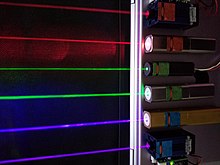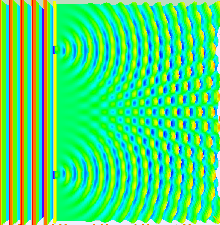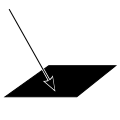light
Light is a form of electromagnetic radiation . In the narrower sense, only those parts of the entire electromagnetic spectrum are meant that are visible to the human eye . In a broader sense, electromagnetic waves of shorter wavelength ( ultraviolet ) and longer wavelength ( infrared ) are also included.
The physical properties of light are described by various models : In ray optics , the straight propagation of light is illustrated by "light rays"; In wave optics , the wave nature of light is emphasized, which can also explain diffraction and interference phenomena . In the quantum physics finally the light as a stream of quantum objects that will photons (illustratively also referred to as "light particles") will be described. Quantum electrodynamics offers a complete description of light . In a vacuum , light propagates at the constant speed of light of 299,792,458 m / s. When light hits matter, it can be scattered , reflected , refracted and slowed down or absorbed .
Light is the appropriate sensory stimulus for the human eye . The intensity of the light is perceived as brightness , the spectral composition as color .
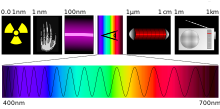
history
Until well into modern times, it was largely unclear what light actually was. It was partly believed that the brightness fills the room without any time lag. Pythagoras believed that "hot rays of vision" emanate from the eyes and are pushed back by other objects. If this were true, humans should also be able to see in the dark. However, there have been ideas since ancient times that light is emitted from the light source at a finite speed.
Galileo Galilei was one of the first to seriously attempt to measure the speed of light propagation , but to no avail. The funds available to him were far too crude for that. Only Ole Rømer succeeded in doing this on the basis of observation data from Jupiter's moons in 1675. The deviation of his measured value from the actual value (approx. 2.3 · 10 8 m / s) was around 30%. The real achievement of Rømer, however, was to prove that light propagates at finite speed. Rømer's measured value became more and more precise in the course of the following 200 years by more and more refined procedures (especially by Hippolyte Fizeau and Léon Foucault ). The nature of light, however, remained unexplained. In the 17th century Isaac Newton tried to explain the propagation of light through the movement of small particles with his corpuscle theory . This made it possible to understand reflection , but not some other optical phenomena, such as diffraction , which is clearly a wave phenomenon. At the same time justified Christiaan Huygens and others the wave theory of light , but which lasted until the early 19th century by the double slit experiments of Thomas Young increasingly prevailed.
Michael Faraday was the first to prove in 1846 that light and magnetism are two interconnected physical phenomena. He published the magneto-optical effect he had found , which is now known as the Faraday effect , under the title On the magnetization of light and the exposure of the lines of magnetic force .
In 1864 James Clerk Maxwell formulated the basic equations of electrodynamics that are still valid today and recognized that this predicted the existence of free electromagnetic waves . Since its predicted speed of propagation coincided with the known speed of light, he concluded that the light was probably an electromagnetic wave. He suspected (like almost all physicists back then) that this wave could not exist in empty space, but needed a medium of propagation. This medium, which should fill the entire universe, was called ether .
With the electromagnetic light theory based on it, almost all questions about light seemed to be clarified in the late 19th century. However, on the one hand, the postulated ether could not be detected (see Michelson-Morley experiment ), which ultimately opened the door to the special theory of relativity . On the other hand, among other things, the photo effect seemed to contradict the wave nature of light. The result was a radically new way of looking at light, which was founded on the quantum hypothesis of Max Planck and Albert Einstein . The core of this hypothesis is the wave-particle dualism , which now describes light no longer exclusively as a wave or exclusively as a particle, but as a quantum object. As such, it unites the properties of waves and particles without being one or the other and thus eludes our concrete perception. This gave rise to quantum physics at the beginning of the 20th century and later quantum electrodynamics , which is still our understanding of the nature of light today.
science
physics
The most important models for describing light are presented below. Like all models in physics, the ones listed here are limited in their scope. As far as we know today, a complete description of the phenomenon “light” can only be provided by quantum electrodynamics.
Light as an electromagnetic wave

In classical electrodynamics, light is understood as a high-frequency electromagnetic wave. In a narrower sense, “light” is only that part of the electromagnetic spectrum that is visible to the human eye, i.e. wavelengths between approx. 380 and 780 nm. It is a transverse wave , the amplitude being given by the vector of the electric field or the magnetic field . The direction of propagation is perpendicular to it. The direction of the -field vector or -field vector is called the polarization direction . With unpolarized light, the radiation field is composed of waves of all polarization directions. Like all electromagnetic waves, visible light also propagates in a vacuum at the speed of light from.
The wave equation of this electromagnetic wave can be derived from Maxwell's equations . This results in a simple relationship between the speed of light, the magnetic field constant and the electric field constant :
in a vacuum,
in the medium.
Obviously, the speed of light - more precisely: the phase speed of light - in media depends on their material properties. These can be summarized in the refractive index . In general, it is frequency dependent, which is called dispersion . Among other things, this is the basis of the prism's ability to split light into its spectral components. With normal dispersion, short-wave blue light (<450 nm) is refracted more strongly than long-wave red light (> 600 nm).
Ray optics
Ray optics (also geometrical optics) make use of the approximation that the propagation of light can be illustrated by straight "rays". This approximation is justified above all when the dimensions of the test arrangement are large compared to the wavelength of the light. Then all diffraction phenomena can be neglected. The link between wave optics and ray optics is the wave vector , the direction of which corresponds to the direction of the light beam. The ray optics are particularly well suited to describe phenomena such as light and shadow , reflection or refraction . Therefore the function of many optical devices ( pinhole camera , magnifying glass , telescope , microscope ) can be explained with it. In particular, the imaging laws are also the basis for understanding the breaking apparatus in the human eye.
Principles of rays
- Rays of light always propagate in a straight line and only change their direction when they hit a body (through reflection, refraction or scattering), regardless of the deflection of light by heavy masses ( gravitational lens effect ) observed in astronomy .
- Rays of light can penetrate each other without affecting each other.
- The light path is reversible. This means that every beam path would satisfy all optical laws even if the direction of propagation of the light were reversed.
reflection
Light is reflected from reflective surfaces (bare metal, water surface) according to the law of reflection . The incoming and outgoing beams as well as the perpendicular on the reflecting surface lie in one plane. The angle of incidence and the angle of reflection are equal to one another. The ratio of the reflected light intensity to the incident light intensity is called the degree of reflection and is dependent on the material and the wavelength. The degree of reflection indicates what percentage of the luminous flux falling on a surface is reflected.
refraction
Light is refracted at the interface between two media of different optical density, i.e. that is, a ray changes direction at this interface. (For the sake of completeness, it should be said that at such a boundary surface the reflection always occurs more or less strongly.) Snellius' law of refraction states:
The incident and refracted rays as well as the perpendicular on the interface lie in one plane. The angle between the perpendicular and the light beam is smaller in the medium with the higher refractive index.
The exact angles can be calculated using the refractive indices of the media involved:
- .
If the incident ray from the optically denser medium hits the interface at a shallow angle, there is no real angle for the refracted ray that satisfies this condition. In this case, total reflection occurs instead of refraction .
Wave optics
The wave optics is based on the principle of Huygens and Fresnel .
Every point of a wave front is the starting point of an elementary wave. A wave front results from the superposition of these elementary waves.
In this context, elementary wave means a spherical wave that emanates from a certain point. Wavefronts are the surfaces of the same phase. The distance between two successive wave fronts is thus the wavelength. The wave fronts of a plane wave are planes, the wave fronts of elementary waves are concentric spherical surfaces. The direction of propagation (i.e. the direction of the wave vector) always forms a normal to the wave front. With wave optics all phenomena of diffraction and interference can be understood. But it is also suitable for deriving the law of reflection and the law of refraction. The wave optics do not contradict the ray optics, but expand and deepen them.
Historically, wave optics by Huygens and Fresnel anticipated an essential finding in electrodynamics: light waves are electromagnetic waves.
Photons
In quantum physics, light is no longer understood as a classical wave, but as a quantum object. Accordingly, light is made up of individual discrete energy quanta, the so-called photons. A photon is an elementary particle, more precisely an elementary boson with a mass of 0, which always moves at the speed of light .
It carries an energy of
Here, the frequency of light, and the Planck's constant with .
The photon has a momentum of
where is the wavelength of light.
A photon is either absorbed and emitted as a whole or not at all. So it is “countable” like a particle. Nevertheless, everything that has been said here about the wave properties of light remains valid. This strange behavior of the photons, which is also shown by all other quantum objects, was described with the catchphrase “wave-particle dualism”: quantum objects are neither to be understood as classical particles nor as classical waves. Depending on the perspective, they show characteristics of one or the other.
In today's most common interpretation of quantum mechanics ( Copenhagen interpretation ), the exact location of a photon cannot be predicted a priori . One can only make statements about the probability with which a photon will hit a certain point. This probability density is given by the square of the magnitude of the amplitude of the light wave.
Historically, the quantum mechanical description of light became necessary because some phenomena could not be explained with purely classical electrodynamics:
- If one imagines a thermal light source (ideally a black body ) as a collection of many atomic oscillators that are in equilibrium with the radiation field, a classic derivation would lead to a "UV catastrophe", short-wave radiation would have to be in the spectrum of the black Body much more strongly represented than it is. ( Rayleigh Jeans Law )
- Classical electrodynamics would predict that the energy of electrons that are released in the photoelectric effect is proportional to the intensity of the absorbed radiation. In fact, it is (apart from a constant summand) proportional to the frequency of the radiation. This connection cannot be understood classically.
- Sensitive detectors (such as photomultipliers ) do not receive a constant, uniformly low intensity when the irradiation is weak, but rather individual signals that are very narrowly limited both spatially and temporally.
- The spectrum of X-ray brake radiation has a short-wave limit that is directly related to the energy of the electrons that were used to generate them.
Interaction with matter
In addition to the phenomena described earlier in this article
there are numerous other interactions between light and matter.
- Absorption : The energy of incident light is swallowed by a body. This can lead to an electron being raised to a higher energy level, the body to heat up, etc. If the radiation is absorbed regardless of its wavelength, the body appears black. If only part of the spectrum is absorbed, the remaining parts of the spectrum determine the color of the body ( subtractive color mixing ). In the case of electronic excitation, the energy can also be released again in the form of radiation. One speaks of spontaneous emission, of fluorescence or - if the process is clearly delayed - of phosphorescence .
- Birefringence : Some materials split a beam of light into two beams of different polarization.
- Optical activity : Certain media can rotate the plane of polarization of polarized light.
- Photo effect : The photons release electrons from the irradiated body.
- Scattering : The light changes its propagation, however not in a defined direction as with the reflection, but diffusely in all possible spatial directions. Depending on the scattering body, a distinction is made between Compton scattering (on free electrons), Rayleigh scattering (on bound electrons without energy transfer), Raman scattering (on bound electrons with energy transfer), Mie scattering (on particles whose expansion is in the Order of magnitude of the wavelength).
Light sources
In principle, a distinction is made between thermal and non-thermal radiators. The former obtain the energy for radiation emission from the thermal movement of their particles. Examples are candle flames, glowing bodies (filament of an incandescent lamp ) and the sun. The spectrum of a thermal radiator is continuous; In other words , all wavelengths occur, the spectral components depending exclusively on the temperature according to Planck's law of radiation , but not on the material of the radiator , apart from the spectral emissivity .
In contrast, non-thermal light sources do not have a continuous spectrum, but a line or band spectrum. This means that only very specific wavelengths are emitted. Line spectra occur with gas discharge tubes , band spectra with light emitting diodes , polar lights or fireflies . The energy sources for the radiation are electric current, particle radiation or chemical reactions. Line spectra are often characteristic of certain substances.
The laser occupies a special position among the light sources . Laser light is almost monochromatic (it consists almost entirely of one wavelength), more or less coherent (there is a fixed phase relationship between several wave trains) and often polarized .
The Cerenkov radiation generated by the movement of charged particles through a transparent dielectric , when the particle velocity is higher than the speed of light in the dielectric. It is the analogue to the sonic boom and can, for example, swimming pool reactors and spent fuel pools of nuclear power plants are observed.
Light receiver
- The intact sense of sight is the simplest proof. Accordingly, the eye plays an important role in the direct observation of processes in which light is involved.
- The photographic film plays an important role in the exploration of the nature of light: you can by long exposure lowest light intensities of distant stars and document their spectra. Photographic layers can be sensitized for different areas of the spectrum. In the meantime, however, photographic film is being replaced more and more by image sensors .
- Optical radiation detectors typically use the outer (photocell, Vidicon , image intensifiers , photomultipliers) and inner ( semiconductor detectors such as photodiode , phototransistor , photoresistor ) photoelectric effect . Complex sensors ( line sensors and image sensors), which also serve as recording elements in scanners and digital cameras , also work with semiconductor detectors. Color sensors work with several photodetectors located behind different filters .
- By fluorescent ultraviolet can and infrared (after a two-photon absorption ) are detected by the resultant visible light is evaluated.
- Light can also be detected through its thermal effect. The bolometers used in astronomy to measure the radiation power of astronomical light sources, as well as thermal power meters for high-power laser beams, are based on this principle .
biology
Light as an eco-factor
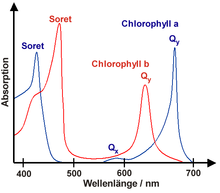
In addition to the availability of water, light is the most important eco-factor for plants because it provides energy for photosynthesis . The light energy absorbed by the chlorophyll molecules in the chloroplasts is used to split water molecules ( photolysis ) and thus produce reducing agents for photosynthesis. These are used in a second step to gradually reduce carbon dioxide to glucose , which is used to build starch , among other things . The oxygen produced during photolysis is released into the atmosphere as a residue. The sum reaction equation of photosynthesis is:
The structure of organic compounds from carbon dioxide is called carbon dioxide assimilation . Organisms that are able to do this with the help of light are called photo - autotroph . In addition to vascular plants , they also include mosses , algae and some bacteria , such as cyanobacteria and purple bacteria . All heterotrophic organisms are dependent on this assimilation because they can only meet their energy needs from organic compounds that they have to ingest with food.
The competition between plants for light becomes noticeable in the “storey structure” of the forest and the associated specialization of light and shade plants or in the seasonal sequence of different aspects . In water bodies, only the light-flooded top layer, the nutrient layer , is used for the formation of biomass and oxygen, mainly through phytoplankton . Because many animals and unicellular organisms find good living conditions here due to the high food supply and the comparatively high oxygen content of the water, they are attracted by the light.
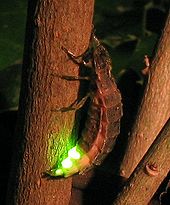
The sense of light or sight is one of the most important senses for many animals. It is used for orientation in space, for controlling the day-night rhythm , for recognizing dangers, for tracking down prey and for communicating with conspecifics. Therefore, in the course of evolution, the most varied light-sensing organs have developed in the most varied of taxa . These range from the simple eye spots of Euglena to simple pigment fields to the complexly structured compound eyes and lens eyes . Only a few animals are completely insensitive to light stimuli. This is only the case when they live in complete darkness, like cave animals.
It is an advantage for both predators and prey not to be seen. Adjustments to this are camouflage and night activity . Amazingly, on the other hand, many living beings have developed the ability to shine themselves. The most famous example is the firefly . This phenomenon of bioluminescence can also be found in deep-sea fish , luminescent crabs , fungi ( Hallimasch ) or bacteria. The benefits of bioluminescence are mainly explained with intra-species communication, deterring predators and attracting prey.
Light as a sensory stimulus
The light that falls into the human eye is projected onto the retina by the breaking apparatus (consisting of the cornea , anterior and posterior chambers of the eye, lens and vitreous humor ) . There a real, upside- down image is created (comparable to a process in a photo camera). This stimulates the photoreceptors (= light sensory cells) in the retina , which convert the stimulus into an electrical signal. This signal is sent to the brain via the optic nerve, into which the individual nerve cords of the retina flow . There the upside-down images of our environment are then "straightened out" in real time.
Light intensity is perceived as brightness . The eye can adapt to the intensities - many powers of ten - through various mechanisms (see adaptation ). The perceived brightness is related to the actual intensity via the Weber-Fechner law .
The spectral composition of the light stimulus is perceived as color , whereby the human eye can detect light with wavelengths between approx. 380 nm and 750 nm. If you split white light (by a prism), the wavelengths appear as the colors of the rainbow.
| (approximately) shade | Wavelength in nm | Wave frequency in THz | Energy E per photon in eV | Wave number in cm −1 | |
|---|---|---|---|---|---|
| violet | 380-420 | 789.5-714.5 | 3.26-2.955 | 26,316-23,810 | |
| blue | 420-490 | 714.5-612.5 | 2.95-2.535 | 23,810-20,408 | |
| green | 490-575 | 612.5-522.5 | 2.53-2.165 | 20,408-17,391 | |
| yellow | 575-585 | 522.5-513.5 | 2.16-2.125 | 17,391-17,094 | |
| orange | 585-650 | 513.5-462.5 | 2.12-1.915 | 17.094-15.385 | |
| red | 650-750 | 462.5-400.5 | 1.91-1.655 | 15,385-13,333 |
It should be noted that this table only applies to monochromatic (single color) light. Mixed colors may produce different color impressions. For example, a mixed color of monochromatic green and red light appears yellow to the human sense of sight.
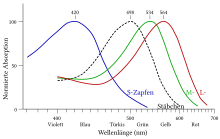
The retina of the eye is equipped with various sensory cells: The rods have a broad spectral response and are characterized by a high level of sensitivity. They are therefore specialized in seeing at twilight, but cannot distinguish between colors. The cones, on the other hand, which are adapted to stronger intensities, come in three different types, each of which has its reaction optimum at a different wavelength. Their interconnection ultimately enables color vision .
The visual process in both rods and cones is based on the absorption of photons by the visual pigment (in the case of rods: rhodopsin ). The ligand Retinal makes up an isomerization by which causes the rhodopsin disintegrates and the signal cascade of the phototransduction is initiated. The resulting hyperpolarization of the cell membrane of the rods and cones produces an electrical signal that is passed on to the downstream nerve cells.
In addition to cones and rods, there is a third light receptor, the melanopsin- containing ganglion cells. These receptors are particularly sensitive to blue light and are involved in controlling the internal clock . Their discovery at the beginning of the millennium accelerated the development of daylight-like lighting concepts for interiors, such as Human Centric Lighting .
The services of the light sense organs of other living beings differ in part considerably from those of humans. While most mammals have a rather underdeveloped color vision, birds have more cone types and can accordingly distinguish more colors than humans. Bees are more or less insensitive to long-wave (red) light, but can perceive very short-wave UV light, which is invisible to humans. They can also perceive the direction of polarization of the light. This helps them to orientate themselves in the room with the help of the sky blue . Some snakes, on the other hand, can perceive the IR rays, which are also invisible to us, with their pit organs .
chemistry
With organic dyes , delocalized π-electrons can be raised to a higher level by frequencies in the visible range. As a result, certain wavelengths are absorbed depending on the molecule .
In the case of inorganic dyes , electrons from the d orbitals of an atom can also be excited into energetically higher d orbitals (see ligand field theory ). Furthermore, electrons can change their position between the central ion and the ligand within a complex (see also charge transfer complexes and complex chemistry ).
Sizes and units
- The speed of light (c) is independent of the movement of the source and decreases in media compared to the speed of light in a vacuum. In a vacuum it is 299,792,458 meters per second and there is also independent of the movement of the observer. The light year (Lj, ly) is the distance that light travels in one year. It is used in astronomy as a unit of length.
- The light color is determined by the spectral composition of the light. The wavelength is inversely proportional to the energy of the light quanta.
- The polarization of light describes the orientation of the electric and magnetic field vectors of light in space. The light reflected flatly on dielectric surfaces and the light from the blue sky is partially linearly polarized, while the light from incandescent lamps and the sun does not have a preferred direction of polarization. Linear and circularly polarized light play a major role in optics and laser technology .
- Luminous flux ( lumen ) indicates how much light a light source emits in all directions.
- The amount of light (lumen second) is the luminous flux integrated over time
- Luminous intensity ( candela ) is the luminous flux per solid angle. The luminous flux can be increased by focusing.
- Luminance (candela / m²) is the light intensity per area of a light emitter (e.g. filament, arc, light-emitting diode).
- Illuminance ( lux ) describes how much light falls on a surface. It is measured with a lux meter.
- The color temperature (Kelvin) is the light color of a light source that is equal to the temperature of a black body with the same temperature in order to classify it with regard to its color impression. The higher the value, the cooler or blue-whiter the light.
The radiation pressure (Newton second) is the physical force of light on particles or objects and, due to its small amount, hardly plays a role.
Light in society
Like fire , light is one of the most important phenomena for all cultures. Artificially generated light from light sources enables people today to live a comfortable and safe life even in terrestrial darkness ( night ) and in covered rooms (caves, buildings). Technically, the functional group that generates light is called a lamp, illuminant or light source. The holder for the lamp forms a light with this .
The categories "light" ( antonym : "dark") and "clear" (antonym: "nebulous") are mostly given positive connotations . In the sentence: “The light of the Enlightenment conquered the darkness of the Middle Ages ”, the ancient, ultimately Manichean motif of the “victory of light over darkness” can be recognized, which can be used as a metaphor in many ways . An example of this is the “ Song of the Moldau ” in Bertolt Brecht's drama Schweyk during World War II : “The night has twelve hours, then the day will come.” As an expression of hope for an end to the dictatorship (as “dark time”) .
In Christianity the light is in the self-designation of Jesus Christ - " I am the light of the world " ( Jn 8,12 EU ) - for the redemption of man from the darkness of distance from God. In the biblical creation story, light is the second work of God after heaven and earth. Charismatics are often referred to as "enlightened" in general. On the other hand, people who have little understanding or insight are often certified to be “not a big lamp”.
As " Achluophobie ", also called "Nyktophobie" (from ancient Greek. Νύξ, νυκτός - nyx, nyktós - f = the night) or as "Skotophobie" (σκότος of, σκότου - Skotos - m = the dark.) Denote psychiatrist the pronounced (partly pathological) fear of the dark. The phobia is common in children, but it can also be found in adults. A less severe form of achluophobia is pavor nocturnus . The fact that the sense of sight can largely not be used in the dark plays a central role in the fear of the dark, which leaves a lot of room for interpretations of what is seen in shadow, of signals from the other senses and of the imagination.
Someone who has lost their mind is often referred to as "mentally deranged".
Year of Light 2015
In view of numerous anniversaries (for example Ibn Al Haythem's Book of Seeing (1021), special and general theory of relativity (1905 and 1915) and the development of glass fiber by Charles Kao (1965)), UNESCO has declared 2015 the International Year of Light . All over the world events took place this year that deal with the importance of light for science and society. In Germany, the German Physical Society coordinated the activities for the Year of Light.
Day of light
After the International Year of Light 2015, the Board has UNESCO in November 2017. International Day of Light (English International Day of Light ) proclaimed. The Day of Light has been celebrated on May 16 every year since 2018.
Light from the perspective of the German legislator
Light counts as an environmental factor to the emissions within the meaning of the Federal Pollution Control Act (BImSchG). Light immissions from lighting systems can significantly disrupt the needs of people and animals to live and sleep and also hinder technical processes. Correspondingly, standards for assessing (room) brightening and (psychological) glare are specified in the “ light guidelines ” of the federal states (in Germany) . Intense colored or flashing light can be particularly disturbing. The environmental and pollution control authorities of the respective federal states are responsible for complaints. Negative effects affecting the traffic safety ( navigation at night, disability glare caused by incorrectly adjusted headlights or area lights next to roads), effects on wildlife (attracting nocturnal insects , disturbance of flying birds migrating birds) and the general lightening of the atmosphere ( light pollution , the astronomical Observations due to the scattering of lamp light in the atmosphere of the night sky).
literature
- Albert Einstein : About a heuristic point of view concerning the generation and transformation of light. In: Annals of Physics . 1905, pp. 132-148. With this contribution, Einstein established the wave-particle dualism of light.
- Rolf Heilmann: Light. The fascinating story of a phenomenon , Herbig, Munich 2013, ISBN 978-3-7766-2711-4 .
- Klaus Hentschel : Einstein and the light quantum hypothesis. In: Naturwissenschaftliche Rundschau. 58, 6, 2005, ISSN 0028-1050 , pp. 311-319.
- Thomas Walther, Herbert Walther: What is light? From classic optics to quantum optics. Beck, Munich 1999, ISBN 3-406-44722-8 .
- Sidney Perkowitz: A Brief History of Light. Exploring a mystery. Deutscher Taschenbuch Verlag, Munich 1998, ISBN 3-423-33020-1 .
- George H. Rieke: Detection of Light - From the Ultraviolet to the Submillimeter. Cambridge Univ. Press, Cambridge 2003, ISBN 0-521-81636-X .
- Wolfgang Schivelbusch : Lichtblicke: On the history of artificial brightness in the 19th century . Fischer Taschenbuch, Frankfurt am Main 2004, ISBN 978-3-596-16180-5 .
Web links
- Extensive information on the physics of light (on the world of physics)
- Encyclopedic history of the term light (lexical references on the subject of light, by Michael Mandelartz)
- Baunetz Knowledge Daylight (online lexicon on daylight and artificial light use)
- Environmental factor light (State Office for Nature, Environment and Consumer Protection NRW)
Videos
- Does light get tired? from the alpha-Centauri television series(approx. 15 minutes). First broadcast on Mar 17 2002.
- What is light from the alpha-Centauri television series(approx. 15 minutes). First broadcast on Dec 8, 2002.
- What was the ether? from the alpha-Centauri television series(approx. 15 minutes). First broadcast on Feb. 4, 2004.
Individual evidence
- ↑ The lighting with artificial light . In: licht.de (Ed.): Licht.wissen . No. 01 . Frankfurt 2016, ISBN 978-3-945220-03-0 , pp. 8 .
- ↑ Bergmann-Schaefer Textbook of Experimental Physics , 10th edition, page 906
- ↑ Michael Faraday: Experimental Researches in Electricity. Nineteenth Series . In: Philosophical Transactions of the Royal Society . Volume 136, 1846, pp. 1-20, doi : 10.1098 / rstl.1846.0001 .
- ↑ James Clerk Maxwell: A Dynamical Theory of the Electromagnetic Field . In: Philosophical Transactions of the Royal Society of London . No. 155 , 1865, pp. 459-512 .
- ↑ Light dictionary. licht.de, accessed on August 20, 2018 .
- ↑ The effect of light on people . In: licht.de (Ed.): Licht.wissen . No. 19 . Frankfurt 2014, ISBN 978-3-926193-97-1 , pp. 15 .
- ^ Official website for the Year of Light in Germany
- ↑ News from licht.de . ( licht.de [accessed October 27, 2017]).
- ^ Official website International Day of Light. Retrieved October 27, 2017 .
- ↑ Light immissions - when light interferes. In: portal page licht.de. Retrieved August 20, 2018 .
- The spectrum of electromagnetic radiation

